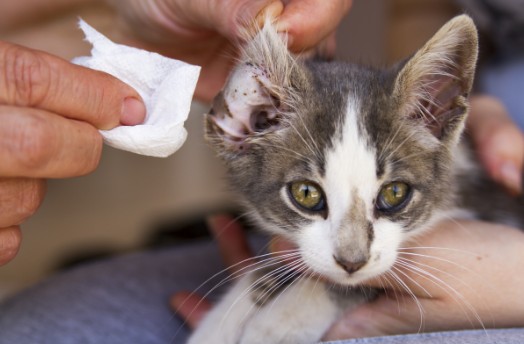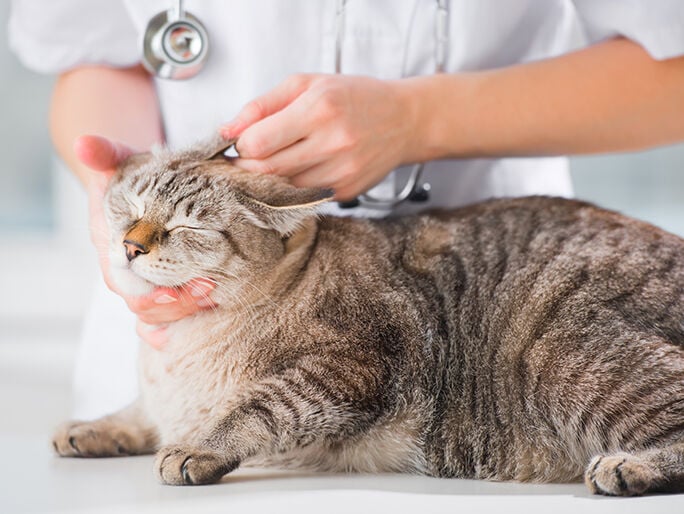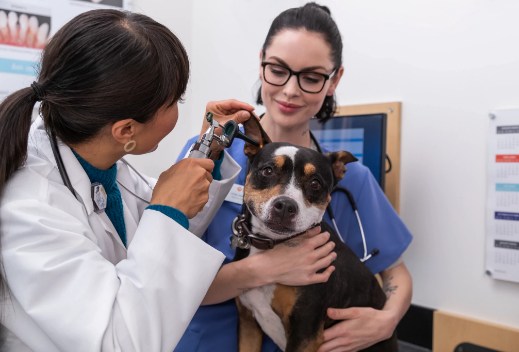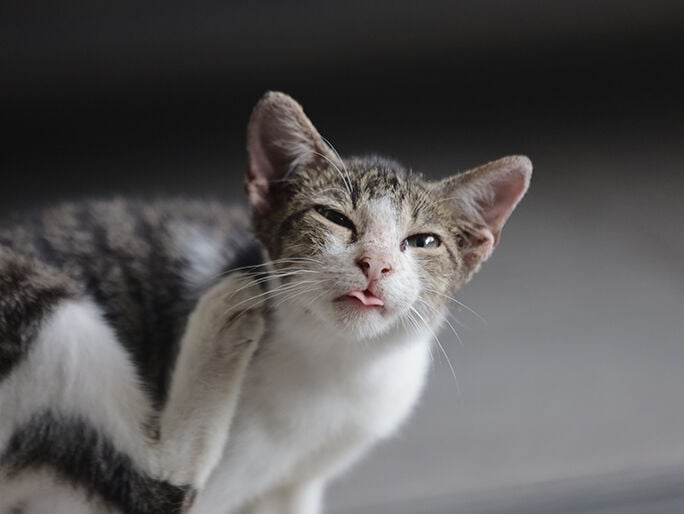ear infections in cats
Kitty ear infections can cause severe and possibly permanent ear damage.
Constant head shaking or pawing and scratching at ears? It’s time to see the vet.

Cat ear infection symptoms
- Unusual head shaking or ear pawing
- Changed ear positions
- Rubbing ears against floors or furniture
- Foul ear odor or waxy discharge
- Bald spots, scabs, or scars around ears
- Red and inflamed ear canals
- Behavior changes (irritation, hiding)

Severe cat ear infection symptoms
- Hearing loss
- Loss of balance
- Strange eye movements
Why cat ear infections are serious health issues
Untreated or poorly managed ear infections can lead to severe (and possibly permanent) ear damage for your cat.

Types of cat ear infections: outer, middle, and inner ears
Cats can get an ear infection (otitis) in three different parts of their ear, and each one needs a different kind of veterinary care and treatment to help your cat.
This complexity is a big reason why an otoscopic exam is part of a complete physical examination for your cat. This special tool helps your veterinary team figure which (if any) of these ear infections your pet may have.
- Otitis externa: an outer ear infection affecting the ear canal
- Otitis media: a middle ear infection near the eardrum
- Otitis interna: an inner ear infection affecting the very innermost parts of the ear
Ear mites and cat ear infections share a lot of the same symptoms
Body language can be a big clue that your cat’s ears are bothering them. Watch for head shaking and pawing or scratching their ears. Other symptoms include physical changes like smelly discharge or crusty ears with raw spots from scratching.
If you spot anything new or strange, try to get a closer look. Don’t take it personally if your cat slaps or hisses at you — infected ears can be tender! Your veterinary team is here to help.
What causes ear infections in cats?
There are many different causes for cat ear infections. Scratching from mites and allergies can cause swelling that leads to infection. So can ear trauma and foreign objects in the ear canal. Even too much waxy buildup inside the ear can create a perfect environment for bacteria or yeast to breed and cause an infection.

Ear mites:
Cat ear infections share many symptoms with an ear mite infestation. It’s also not unusual for ear mites to cause a secondary, “opportunistic” ear infection.

Inner ear shape:
Some kinds of cat ears, like those with folded ear flaps and small ear canals, can trap moisture and create a rich environment for bacteria and yeast.

Allergies:
General itchiness and inflammation from allergies can lead to infections.

Foreign material or ear masses:
Cats can get seeds and other small objects stuck in their ears, which can lead to an ear infection. Tumors large and small can also cause the same problem.
How to treat ear infections in cats
While no cat has out-and-out told us, cat body language indicates ear infections can be uncomfortable or painful. An untreated or poorly managed ear infection can also cause permanent hearing loss and balance problems in cats.
Here’s what to do and know.
Why cat ear infection treatment needs the vet
Please don’t put anything in your cat’s ears until you’ve spoken with your vet! Many “solutions” you find on the internet (like tea tree oil, apple cider vinegar, or hydrogen peroxide) may not treat the actual problem and can cause even more irritation.Ear mites and ear infections share a lot of the same symptoms, and it’s just too easy to “treat” the wrong thing — and cause pain and damage if your pet’s ear drum has been ruptured.

What can the vet do to help my cat’s ear infection?
When you come in, we’ll ask for information on your cat’s recent history, like the symptoms you’ve seen and when you think they started. Let us know if your cat has allergies, if they’ve had ear infections before, or if you think something may be stuck down in your cat’s ear.
We’ll perform a physical exam and take a good look inside your cat’s ears with an otoscope, a tool that helps us to see physical symptoms or damage in the ear canal. We’ll also take a sample of ear goop to test for ear mites, yeast, and bacteria.
Once we’ve diagnosed your kitty with an ear infection, we’ll give you the full rundown on treatment. We’ll recommend an ear cleaner, prescribe appropriate medication, and walk you through how to clean your cat’s ears and apply their meds. In some cases, we’ll also prescribe some pain meds to help relieve your kitty’s discomfort.
How can you help prevent ear infections?
Keep an eye on your cat’s ears and ear-related behavior. You can also ask your vet if regular ear cleaning could help, and how often it should be done. We’re happy to provide advice, how-to, and recommended ear cleaners that are safe for cats.
Mentioned in this article

Does your cat have ear mites?
What to know about ear mites in cats and kittens.

Ear care for cats
Does your cat have ear mites or an ear infection?

Need advice on flea control? Ping Pet Chat™!
Whether it's 3 a.m. or 3 p.m., connect with a real veterinary professional for immediate petcare advice. It's included in all Optimum Wellness Plans®!
Log in to start chattingHow Banfield can help with ear care for cats and dogs
We take happy, healthy pet ears seriously! Our vets can help you find out what’s causing your pet’s ear issues, work with you on a treatment plan, and prescribe safe and effective medications to help treat your pet. We can even work with you to help prevent future problems.

We can work with you to help manage chronic ear infections. If you notice your pet is getting ear infection after ear infection, let’s discuss underlying causes, solutions, and possible prevention for your pet’s issues.
We can provide guidance for cleaning and medicating dog and cat ears. Infected ears can be tender, which may make it rough to treat them at home. Let us know if your pet absolutely refuses to cooperate — we’re here to help!
We can help identify and manage food or environmental allergies that can cause ear infections and skin itchiness and irritation. If you suspect an allergy is causing your pet to sneeze, wheeze, itch, or scratch, we’re here with professional guidance to help your pet.
Any other health concerns?
Just let us know. We’re here to help with loving veterinary care, including your pet’s adorable ears.
 Mites and mange
Mites and mange Podcast - Not Just Fluff
Podcast - Not Just Fluff



